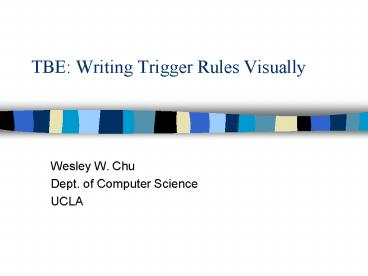TBE: Writing Trigger Rules Visually PowerPoint PPT Presentation
Title: TBE: Writing Trigger Rules Visually
1
TBE Writing Trigger Rules Visually
- Wesley W. Chu
- Dept. of Computer Science
- UCLA
2
Introduction
- Triggers
- A useful feature for push technology (e.g.,
active DB, sensors). - Difficult to understand and compose trigger
rules. - QBE (Query-By-Example)
- Visual query interface.
- Guide users to write only admissible SQL queries
in an intuitive and visual manner. - TBE (Trigger-By-Example)
- Use QBE idea in writing trigger rules.
- Based on SQL3 specification.
3
QBE (Query-By-Example)
- SQL query is represented within two-dimensional
skeleton tables by filling examples of the
answers. - Variables names are lowercase alphabets with
prefix _. - System commands are uppercase alphabets with
suffix .. - Constants are denoted without quote (unlike
SQL3). - Example Schema
- emp and dept relations.
- key attributes Eno and Dno (underlined).
- foreign key attributes emp.DeptNo references to
dept.Dno and dept.MgrName references to emp.Eno.
emp (Eno, Ename, DeptNo, Sal) dept (Dno,
Dname, MgrNo)
4
QBE Example Who is being managed by the manager
Tom?
SELECT E2.Ename FROM emp E1, emp E2, dept
D WHERE E1.Ename Tom AND E1.Eno D.MgrNo
AND E2.DeptNo D.Dno
emp Eno Ename DeptNo Sal _e
Tom P. _d
E1
E2
dept Dno Dname MgrNo _d
_e
D
5
TBE Model
- TBE ECA rules QBE
- TBE has 3 distinct skeleton tables and condition
boxes. - Each E, C, A rule in trigger rule maps to the
corresponding skeleton table with the same prefix
E., C., A., respectively. - INSERT, DELETE, UPDATE are denoted by I., D., U.
system commands. - Since I. and D. affects the whole tuple, they
must be filled in the table name column (i.e.,
leftmost) of the skeleton tables.
6
Event Skeleton Table Examples
(1)
(2)
E.dept Dno Dname MgrNo I.
E.dept Dno Dname MgrNo D.
(3)
(4)
E.dept Dno Dname MgrNo U.
U.
E.dept Dno Dname MgrNo U.
- (1) (2) INSERT and DELETE events on dept
table. - (3) UPDATE event of columns Dname and MgrNo.
- (4) UPDATE event of any columns on dept table.
7
Activation Time Granularity
- SQL3 trigger has two activation time modes
- BEFORE triggers execute before their events.
(BFR.) - AFTER triggers execute after their events.
(AFT.) - SQL3 trigger has two granularities
- Row-level triggers are executed once for each
modification to tuple. (R.) - Statement-level triggers are executed once for
an event regardless of the number of tuples
affected. (S.)
8
Transition Values
- When an event occurs and values change, trigger
rules need to refer to the before or after values
(i.e., transition values) of the triggered
attributes. - SQL3
- Row-level OLD and NEW.
- Statement-level OLD_TABLE and NEW_TABLE.
- TBE provides equivalent built-in functions
- Row-level OLD() and NEW().
- Statement-level OLD_TABLE() and NEW_TABLE().
- OLD_TABLE() returns a set of tuples with values
before the changes. - NEW() returns a single tuple with value after the
change.
9
TBE Event Example Every time more than 10
employees are inserted (statement-level)
E.emp Eno Ename DeptNo Sal AFT.I.S. _n
E.conditions CNT.ALL.NEW_TABLE(_n) gt 10
- The rule is activated after activation time
(AFT.), after insertion event (I.), for each
statement (S.). - Use a built-in function CNT. to count the number
of employee tuples inserted. - ALL. keeps duplicates in counting.
- Two skeleton tables are linked by the same
variable _n.
10
TBE Statement Box
- SQL3 trigger allows arbitrary SQL procedural
statements (e.g., IF, CASE, assignment
statements) in the action part of the rules. - TBE uses a special box similar to QBE condition
box denoted as statement box with A. prefix. - Fill in arbitrary SQL statements delimited by
- Fill in action part of the trigger rules.
11
TBE Simple Example When a manager is deleted,
all employees in his dept are deleted too.
CREATE TRIGGER ManagerDelRule AFTER DELETE On
emp FOR EACH ROW DELETE FROM emp E WHERE
E.DeptNo IN (SELECT D.Dno FROM dept D WHERE
D.MgrNo OLD.Eno)
E.emp Eno Ename DeptNo Sal AFT.D.R. _e
A.dept Dno Dname MgrNo _d
_e
A.emp Eno Ename DeptNo Sal D.
_d
12
(No Transcript)
13
TBE Construction Process Example
- When an employees salary is changed more than
twice within the same year, record new values of
Eno and Sal into the log(Eno, Sal) table. There
is another table sal-change(Eno, Year, Cnt) that
keeps track of the employees salary changes.
CREATE TRIGGER TwiceSalaryRule AFTER UPDATE OF
Sal ON emp FOR EACH ROW WHEN EXISTS (SELECT
FROM sal-change WHERE Eno NEW.Eno AND Year
CURRENT_YEAR AND Cnt gt 2) BEGIN ATOMIC UPDATE
sal-change SET Cnt Cnt 1 WHERE Eno
NEW.Eno AND Year CURRENT_YEAR INSERT INTO
log VALUES (NEW.Eno, NEW.Sal) END
14
Context-sensitive pop-up menu.
Writing condition.
15
(No Transcript)
16
Summary
- TBE
- Easy in writing trigger rules.
- Visual
- Admit only valid input
- Support SQL3 triggers.
- Support Oracle, Sybase triggers by universal
trigger mapping. - Statement box to support arbitrary action
statements. - Future work
- Support for composite event triggers.
- Support for interactions among multiple triggers.
- http//www.cobase.cs.ucla.edu/projects/tbe/

